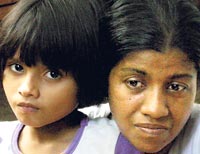Another teenager is dead. No one will know what drove 13-year-old K.D. Ishara Madhushani from Kirulapone to take the most drastic measure in her young life -- that of committing suicide.
Ishara who walked home from school late that day with her younger sister, had her lunch as usual, says father K.D.R. Prasad Kumara, while mother W. Anoma Perera adds that soon after as was her routine she went into her room.
 |
 |
| A grieving family: Ishara was more than a statistic to them |
“She wraps a saree around herself, sits her dolls in a row, takes a kotta (cane) and teaches them, walking up and down,” says Anoma.
When the family realized that she was in the room for a long time, found the door locked and peeped in through a window, it was too late. Ishara was dead by the time she was taken to hospital and when the Sunday Times visited their home on Thursday, relatives and friends had gone back to their own homes and the family had given the heel dane in her memory to the temple nearby.
Ishara died on September 17, taking the toll of “teenage suicides” one notch higher. Ironically, though the Sunday Times contacted many authorities to check how many teenagers had committed suicide during the past three months, not one had the vital statistics at hand.
What is the cause of these ominous teenage suicides?
Ninety percent of teenage suicides are because of a diagnosable mental health problem, mainly depression, stresses Professor Hemamali Perera, Prof. in Psychological Medicine, Faculty of Medicine, University of Colombo, lamenting, however, that this condition has gone unnoticed and unidentified not only by parents and teachers but also by doctors.
| What to look for |
“Functional deterioration” is the danger signal which indicates that your adolescent has a mental illness, the Sunday Times understands.
Explaining that without identifying the problem, parents and teachers will attempt to discipline the adolescent for not performing well in his/her studies etc., Prof. Perera says. “Depression in adolescents is very subtle.”
The symptoms of depression may be irritability, aggression, intolerance, falling school performance, being argumentative, defiance and opposition to parents, anti-social behaviour and loss of control, anxiety, loss of concentration, emotional difficulties, difficulties with peers, difficulties with examinations and in some cases substance abuses.
|
The suicide is precipitated by just one incident which is the last straw and is the culmination of a series of negative life events, explains Prof. Perera who has a mental health clinic for adolescents at the National Hospital, Colombo.
In Sri Lanka, tragically, the main cause of death in the age group 15-25 is suicide, she says, citing the National Health Bulletin, as opposed to figures in the west where accidents and homicides come first and second.
One in 5 (18.9%) of adolescents in Sri Lanka, meanwhile, had clinically significant mental health problems that need help, a 2005 school survey of 2,000 adolescents conducted by Prof. Perera had found. The survey had been among schools in all parts of the country including some areas of the east.
Worries about school performance, pressure from parents to achieve academic excellence, economic and other losses affecting the family, bereavement, being accused of wrong-doing by school authorities or law enforcement agents were some of the situations that were rated as highly stressful by our adolescents. Teenagers experiencing multiple and ongoing stresses of this nature should be considered as having a potential for suicide, she explained.
“Culturally, we, as individuals, seem to lack coping strategies and are very bad at problem-solving,” she says, adding that such skills including resilience seem to be better when we face disasters such as the tsunami and the conflict collectively. Referring to the Central Bank bomb blast, where there was a massive demand for coping skills, she said that several survivors committed suicide. “A collective response to the problems that life throws up is different and less intense than that to the individual crises.”
| Who’s most at risk |
Quoting studies done in the west, Prof. Perera says adolescents who could be most at risk for suicide are:
Those ill-treated in childhood
Have problematic family relationships
Have socio-economic problems
A family history of suicide
Peer problems
History of bullying and victimization
Discipline problems |
Dispelling the “myths” linked to adolescence that hormonal changes make children in this age group emotional and irritable, Prof. Perera points out that this is one reason why mental health disturbances go unidentified. “If such mood swings are very intense and persistent it may not be the hormones but a mental health issue, so take your child to a doctor,” she advises parents, adding that if teachers spot them they should inform the parents as soon as possible.
Another pointer to a mental health issue will be a totally out of proportion reaction of an adolescent to a simple request or suggestion, says Prof. Perera. (See box for symptoms)
She also alerts both parents and teachers about bullying in schools, which she says most teachers are not willing to acknowledge. When children change not only the school but also the environment after the Grade 5 scholarship examination and the O/Ls, there could be a major psychological impact. Girls are more prone to commit suicide due to bullying than boys, it is learnt.
“Be vigilant,” urges Prof. Perera to parents, teachers and doctors, adding that by spotting the silent cries of help from adolescents who may be having some kind of mental disturbance this ominous trend of teenage suicides can be stemmed. |


